Colocalization of hyperpolarization-activated, cyclic nucleotide-gated channel subunits in rat retinal ganglion cells
- PMID: 21456027
- PMCID: PMC3287082
- DOI: 10.1002/cne.22638
Colocalization of hyperpolarization-activated, cyclic nucleotide-gated channel subunits in rat retinal ganglion cells
Abstract
The current-passing pore of mammalian hyperpolarization-activated, cyclic nucleotide-gated (HCN) channels is formed by subunit isoforms denoted HCN1-4. In various brain areas, antibodies directed against multiple isoforms bind to single neurons, and the current (I(h)) passed during hyperpolarizations differs from that of heterologously expressed homomeric channels. By contrast, retinal rod, cone, and bipolar cells appear to use homomeric HCN channels. Here, we assess the generality of this pattern by examining HCN1 and HCN4 immunoreactivity in rat retinal ganglion cells, measuring I(h) in dissociated cells, and testing whether HCN1 and HCN4 proteins coimmunoprecipitate. Nearly half of the ganglion cells in whole-mounted retinae bound antibodies against both isoforms. Consistent with colocalization and physical association, 8-bromo-cAMP shifted the voltage sensitivity of I(h) less than that of HCN4 channels and more than that of HCN1 channels, and HCN1 coimmunoprecipitated with HCN4 from membrane fraction proteins. Finally, the immunopositive somata ranged in diameter from the smallest to the largest in rat retina, the dendrites of immunopositive cells arborized at various levels of the inner plexiform layer and over fields of different diameters, and I(h) activated with similar kinetics and proportions of fast and slow components in small, medium, and large somata. These results show that different HCN subunits colocalize in single retinal ganglion cells, identify a subunit that can reconcile native I(h) properties with the previously reported presence of HCN4 in these cells, and indicate that I(h) is biophysically similar in morphologically diverse retinal ganglion cells and differs from I(h) in rods, cones, and bipolar cells.
Copyright © 2011 Wiley-Liss, Inc.
Figures











Similar articles
-
Molecular identity, ontogeny, and cAMP modulation of the hyperpolarization-activated current in vestibular ganglion neurons.J Neurophysiol. 2012 Oct;108(8):2264-75. doi: 10.1152/jn.00337.2012. Epub 2012 Jul 25. J Neurophysiol. 2012. PMID: 22832570
-
Hyperpolarization-activated, cyclic AMP-gated, HCN1-like cation channel: the primary, full-length HCN isoform expressed in a saccular hair-cell layer.Neuroscience. 2003;118(2):525-34. doi: 10.1016/s0306-4522(02)00913-2. Neuroscience. 2003. PMID: 12699787
-
Involvement of hyperpolarization-activated, cyclic nucleotide-gated cation channels in dorsal root ganglion in neuropathic pain.Sheng Li Xue Bao. 2008 Oct 25;60(5):579-80. Sheng Li Xue Bao. 2008. PMID: 18958363
-
HCN channels: structure, cellular regulation and physiological function.Cell Mol Life Sci. 2009 Feb;66(3):470-94. doi: 10.1007/s00018-008-8525-0. Cell Mol Life Sci. 2009. PMID: 18953682 Free PMC article. Review.
-
Hyperpolarization-activated and cyclic nucleotide-gated channel proteins as emerging new targets in neuropathic pain.Rev Neurosci. 2019 Jul 26;30(6):639-649. doi: 10.1515/revneuro-2018-0094. Rev Neurosci. 2019. PMID: 30768426 Review.
Cited by
-
Circadian rhythm of contrast sensitivity is regulated by a dopamine-neuronal PAS-domain protein 2-adenylyl cyclase 1 signaling pathway in retinal ganglion cells.J Neurosci. 2013 Sep 18;33(38):14989-97. doi: 10.1523/JNEUROSCI.2039-13.2013. J Neurosci. 2013. PMID: 24048828 Free PMC article.
-
Directional summation in non-direction selective retinal ganglion cells.PLoS Comput Biol. 2013;9(3):e1002969. doi: 10.1371/journal.pcbi.1002969. Epub 2013 Mar 14. PLoS Comput Biol. 2013. PMID: 23516351 Free PMC article.
-
Voltage- and calcium-gated ion channels of neurons in the vertebrate retina.Prog Retin Eye Res. 2019 Sep;72:100760. doi: 10.1016/j.preteyeres.2019.05.001. Epub 2019 May 10. Prog Retin Eye Res. 2019. PMID: 31078724 Free PMC article. Review.
-
Organ of Corti explants direct tonotopically graded morphology of spiral ganglion neurons in vitro.J Comp Neurol. 2016 Aug 1;524(11):2182-207. doi: 10.1002/cne.23940. Epub 2015 Dec 25. J Comp Neurol. 2016. PMID: 26663318 Free PMC article.
-
Dopamine and full-field illumination activate D1 and D2-D5-type receptors in adult rat retinal ganglion cells.J Comp Neurol. 2012 Dec 1;520(17):4032-49. doi: 10.1002/cne.23159. J Comp Neurol. 2012. PMID: 22678972 Free PMC article.
References
-
- Abbas SY, Ying SW, Goldstein PA. Compartmental distribution of hyperpolarization-activated cyclic-nucleotide-gated channel 2 and hyperpolarization-activated cyclic-nucleotide-gated channel 4 in thalamic reticular and thalamocortical relay neurons. Neurosci. 2006;141:1811–1825. - PubMed
-
- Bhongsatiern J, Ohtsuki S, Tachikawa M, Hori S, Terasaki T. Retinal-specific ATP-binding cassette transporter (ABCR/ABCA4) is expressed at the choroid plexus in rat brain. J Neurochem. 2005;92:1277–1280. - PubMed
-
- Biel M, Michalakis S. Cyclic nucleotide-gated channels. Handb Exp Pharm. 2009;191:111–136. - PubMed
Publication types
MeSH terms
Substances
Grants and funding
LinkOut - more resources
Full Text Sources
Other Literature Sources
Molecular Biology Databases

